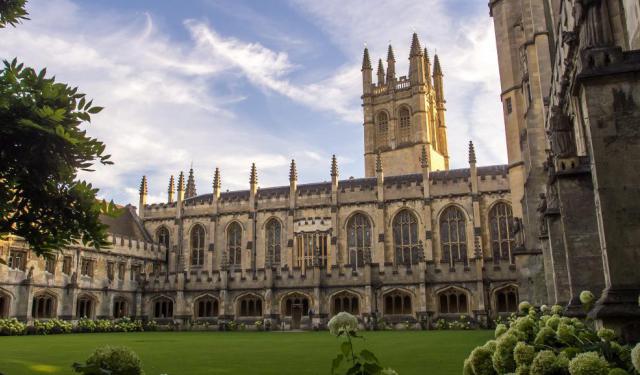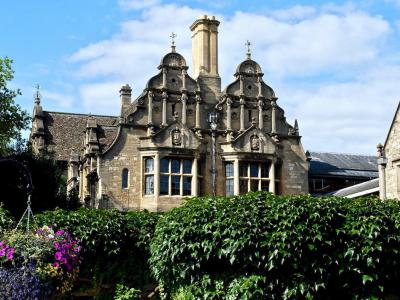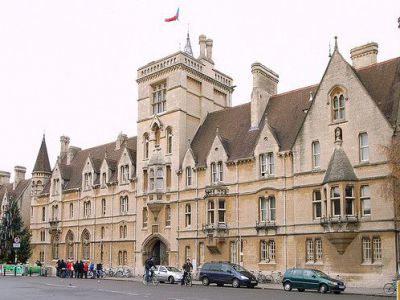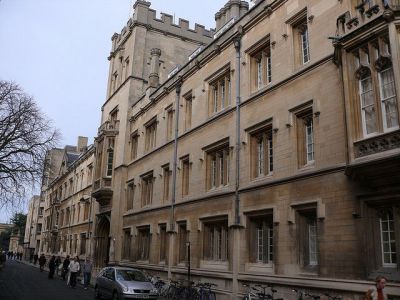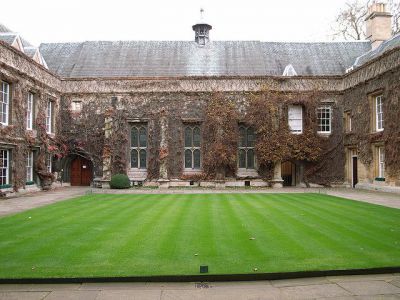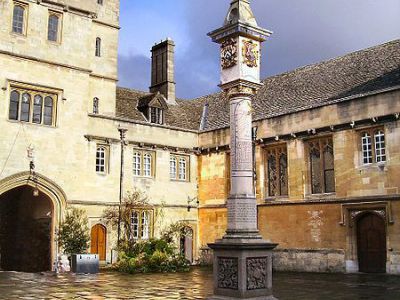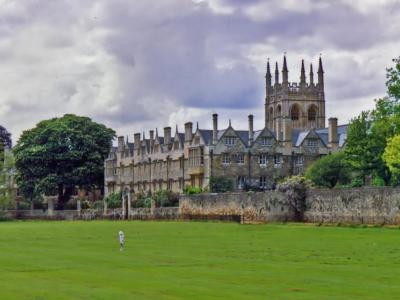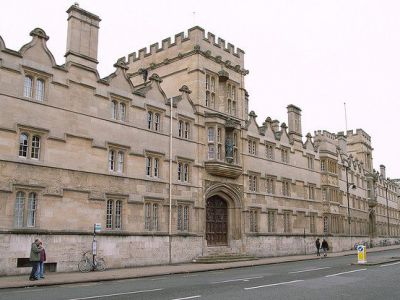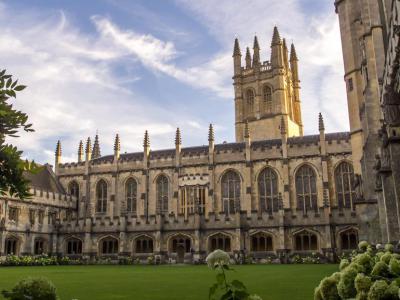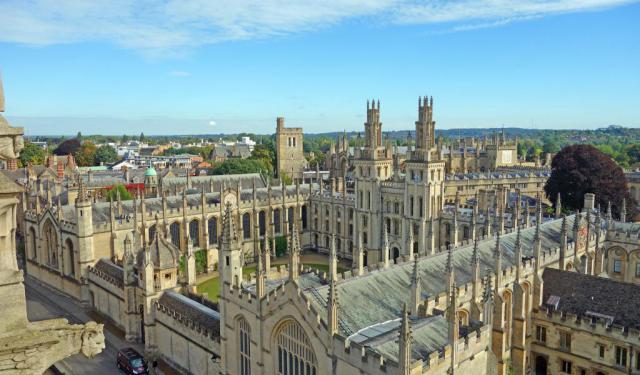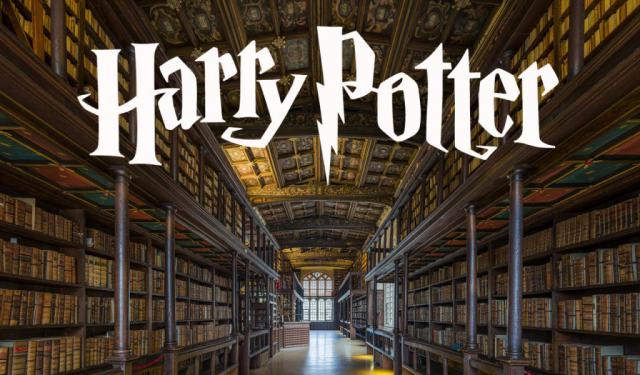Colleges of Oxford University (Self Guided), Oxford
The University of Oxford is the oldest educational institution in England and one of the best in the world. Alma mater for thousands of the most influential people on the planet, it is also a major attraction for architecture and history buffs.
The university represents a "federation" incorporating 38 self-governing colleges and six permanent private halls. Let's take a closer look at some of these prestigious institutions, each with its unique history and character.
Located in the heart of Oxford, Trinity College is known for its beautiful gardens and historic buildings. It has a strong emphasis on science and mathematics.
Situated nearby, Balliol College is one of the oldest colleges at Oxford. It's known for its intellectual atmosphere and a tradition of producing influential scholars.
Located in Turl Street, Exeter College boasts a stunning chapel and a mix of modern and traditional architecture. It has a strong focus on humanities.
Lincoln College stands out for its picturesque setting and academic excellence in various fields.
Corpus Christi College, situated on Merton Street, is known for its intimate atmosphere and strong tutorial system. This is one of the smaller colleges in Oxford.
Meanwhile, Merton College, founded in the 13th century, is known for its beautiful quad and academic achievements. It has a strong presence in science and arts.
University College, often referred to as "Univ," is one of the oldest colleges and has a rich history. It is known for its liberal arts curriculum.
At the same time, Magdalen College, nestled beside the Cherwell River, is famous for its deer park and iconic tower.
Each college at Oxford University offers a unique academic and social experience. The history, architecture, and traditions of these institutions make studying at Oxford a truly enriching experience. If you're considering pursuing your education here, explore these colleges further on our self-guided walk and discover the one that resonates with you the most.
The university represents a "federation" incorporating 38 self-governing colleges and six permanent private halls. Let's take a closer look at some of these prestigious institutions, each with its unique history and character.
Located in the heart of Oxford, Trinity College is known for its beautiful gardens and historic buildings. It has a strong emphasis on science and mathematics.
Situated nearby, Balliol College is one of the oldest colleges at Oxford. It's known for its intellectual atmosphere and a tradition of producing influential scholars.
Located in Turl Street, Exeter College boasts a stunning chapel and a mix of modern and traditional architecture. It has a strong focus on humanities.
Lincoln College stands out for its picturesque setting and academic excellence in various fields.
Corpus Christi College, situated on Merton Street, is known for its intimate atmosphere and strong tutorial system. This is one of the smaller colleges in Oxford.
Meanwhile, Merton College, founded in the 13th century, is known for its beautiful quad and academic achievements. It has a strong presence in science and arts.
University College, often referred to as "Univ," is one of the oldest colleges and has a rich history. It is known for its liberal arts curriculum.
At the same time, Magdalen College, nestled beside the Cherwell River, is famous for its deer park and iconic tower.
Each college at Oxford University offers a unique academic and social experience. The history, architecture, and traditions of these institutions make studying at Oxford a truly enriching experience. If you're considering pursuing your education here, explore these colleges further on our self-guided walk and discover the one that resonates with you the most.
How it works: Download the app "GPSmyCity: Walks in 1K+ Cities" from Apple App Store or Google Play Store to your mobile phone or tablet. The app turns your mobile device into a personal tour guide and its built-in GPS navigation functions guide you from one tour stop to next. The app works offline, so no data plan is needed when traveling abroad.
Colleges of Oxford University Map
Guide Name: Colleges of Oxford University
Guide Location: England » Oxford (See other walking tours in Oxford)
Guide Type: Self-guided Walking Tour (Sightseeing)
# of Attractions: 8
Tour Duration: 1 Hour(s)
Travel Distance: 1.5 Km or 0.9 Miles
Author: Linda
Sight(s) Featured in This Guide:
Guide Location: England » Oxford (See other walking tours in Oxford)
Guide Type: Self-guided Walking Tour (Sightseeing)
# of Attractions: 8
Tour Duration: 1 Hour(s)
Travel Distance: 1.5 Km or 0.9 Miles
Author: Linda
Sight(s) Featured in This Guide:
- Trinity College
- Balliol College
- Exeter College
- Lincoln College
- Corpus Christi College
- Merton College
- University College
- Magdalen College
1) Trinity College (must see)
Oxford University had its origins in academic institutions and monastery buildings where theology was the primary subject of study. However, these early establishments did not survive the Reformation period. Trinity College, located on Broad Street, now occupies the site where Durham College Monastery was established back in 1268.
The only remaining part of the original monastery is the east section of Durham Quad, which now houses the college library. In 1555, Sir Thomas Pope purchased the buildings and land with the intent of creating a college. He hoped that future generations would remember him through their prayers since he had no children to carry on his legacy. His final resting place is within the chapel, next to the altar.
The college's West Tower is adorned with four statues representing Astronomy, Geometry, Medicine, and Music. In 1688, a two-story building designed by Sir Christopher Wren was constructed in the Garden Quad to accommodate students. The neoclassical chapel, designed by Henry Aldrich, was added in 1694.
In 1883, the college underwent expansion, with the construction of the Front Quad overseen by Sir Thomas Jackson. In 1928, the Memorial Library was erected to honor the members who had lost their lives during World War I. Further expansion took place in the 1960s when several cottages and 17th-century houses were acquired, and the Cumberbatch Building was built in 1966.
Despite its considerable physical footprint, the college maintains a relatively modest student population of around 400. Initially established as a men's college, it became coeducational in 1979. Trinity College boasts the distinction of having produced three British Prime Ministers: Spencer Compton (1742–1743), William Pitt the Elder (1766–1768), and Frederick North (1770–1782). This places it third in terms of former students who have held the prestigious office, following Christ Church and Balliol College in that regard.
The only remaining part of the original monastery is the east section of Durham Quad, which now houses the college library. In 1555, Sir Thomas Pope purchased the buildings and land with the intent of creating a college. He hoped that future generations would remember him through their prayers since he had no children to carry on his legacy. His final resting place is within the chapel, next to the altar.
The college's West Tower is adorned with four statues representing Astronomy, Geometry, Medicine, and Music. In 1688, a two-story building designed by Sir Christopher Wren was constructed in the Garden Quad to accommodate students. The neoclassical chapel, designed by Henry Aldrich, was added in 1694.
In 1883, the college underwent expansion, with the construction of the Front Quad overseen by Sir Thomas Jackson. In 1928, the Memorial Library was erected to honor the members who had lost their lives during World War I. Further expansion took place in the 1960s when several cottages and 17th-century houses were acquired, and the Cumberbatch Building was built in 1966.
Despite its considerable physical footprint, the college maintains a relatively modest student population of around 400. Initially established as a men's college, it became coeducational in 1979. Trinity College boasts the distinction of having produced three British Prime Ministers: Spencer Compton (1742–1743), William Pitt the Elder (1766–1768), and Frederick North (1770–1782). This places it third in terms of former students who have held the prestigious office, following Christ Church and Balliol College in that regard.
2) Balliol College
Balliol College is situated on Broad Street and boasts a rich history, having been established in 1263, making it the second oldest among Oxford University's colleges. Its founder, John de Balliol, once served as the Sheriff of Nottinghamshire, although this occurred in a different era than the legendary exploits of Robin Hood and his Merry Men in Sherwood Forest.
The original structures of the college have long since vanished, with the oldest surviving sections dating back to 1431, comprising the north and west ranges of the Front Quad. The Masters' Dining Hall, libraries, and Senior Common Room, though slightly older, also contribute to its historical charm. The buildings surrounding the Garden Quad are more recent additions, with the south-west side being constructed in 1720, the Fisher Building in 1759, the west side in 1826, the Masters' Lodgings in 1860, and the Junior Common Room in 1912. In 1857, the chapel, designed by William Butterfield, was erected.
Balliol College has its share of cherished traditions, one of which hails from the 1960s when a student introduced a tortoise named Rosa to the college. Rosa resided there for an impressive 43 years, and the individual responsible for her well-being held the esteemed title of "Comrade Tortoise." Rosa disappeared in 2004, but another tortoise has since taken her place.
Each June, Corpus Christi College hosts a tortoise race, with students bringing their own tortoises to participate. During Rosa's tenure, Balliol College emerged victorious in the race three or four times, and they continue to harbor high hopes for her successor.
The list of notable alumni from Balliol College is impressive and includes the current (as of 2020) Prime Minister of the United Kingdom, Boris Johnson, as well as three former prime ministers, H. H. Asquith, Harold Macmillan, and Edward Heath. Other distinguished alumni encompass Harald V of Norway, Empress Masako of Japan, five Nobel laureates, and a multitude of literary and philosophical luminaries such as Shoghi Effendi, Adam Smith, Gerard Manley Hopkins, and Aldous Huxley.
The original structures of the college have long since vanished, with the oldest surviving sections dating back to 1431, comprising the north and west ranges of the Front Quad. The Masters' Dining Hall, libraries, and Senior Common Room, though slightly older, also contribute to its historical charm. The buildings surrounding the Garden Quad are more recent additions, with the south-west side being constructed in 1720, the Fisher Building in 1759, the west side in 1826, the Masters' Lodgings in 1860, and the Junior Common Room in 1912. In 1857, the chapel, designed by William Butterfield, was erected.
Balliol College has its share of cherished traditions, one of which hails from the 1960s when a student introduced a tortoise named Rosa to the college. Rosa resided there for an impressive 43 years, and the individual responsible for her well-being held the esteemed title of "Comrade Tortoise." Rosa disappeared in 2004, but another tortoise has since taken her place.
Each June, Corpus Christi College hosts a tortoise race, with students bringing their own tortoises to participate. During Rosa's tenure, Balliol College emerged victorious in the race three or four times, and they continue to harbor high hopes for her successor.
The list of notable alumni from Balliol College is impressive and includes the current (as of 2020) Prime Minister of the United Kingdom, Boris Johnson, as well as three former prime ministers, H. H. Asquith, Harold Macmillan, and Edward Heath. Other distinguished alumni encompass Harald V of Norway, Empress Masako of Japan, five Nobel laureates, and a multitude of literary and philosophical luminaries such as Shoghi Effendi, Adam Smith, Gerard Manley Hopkins, and Aldous Huxley.
3) Exeter College
Exeter College's primary entrance is located on Turl Street. It holds the distinction of being the fourth oldest college within the esteemed Oxford University, established back in 1314. Its founder, Walter de Stapleton, who served as the Bishop of Exeter, envisioned a modest institution dedicated to the education of future clergymen. In its early days, the college had space for just 15 students simultaneously.
During the 16th century, the college underwent significant expansion thanks to the generosity of Sir William Petre, an alumnus who included it in his will. The Front Quad, completed in 1710, stands on the site of the original medieval buildings, with only Palmer's Tower from 1432 surviving from that era. At the base of the tower, you'll find a memorial honoring the college members who lost their lives during the Second World War.
The quad also features the impressive Great Hall, constructed in 1618, showcasing a stunning vaulted ceiling. However, the quad is somewhat overshadowed by the chapel, designed by Sir George Scott in 1860, inspired by the Sainte Chapelle in Paris.
In Fellows Garden, you'll find the Library designed by Sir George in the style of the 13th century. To the left of the Garden, you'll encounter the Divinity School and Convocation House, with Brasenose Lane on the right, and at the far end, the Mound, offering scenic views of Radcliffe Camera and All Souls College.
Margary Quad includes the Rector's Lodging, another creation of Sir George, while the remainder of the quad was completed in 1964, including the Thomas Wood Building, commemorating the college's 650th anniversary.
Initially, Exeter College drew students primarily from the Devonshire gentry. However, over time, it has become associated with a diverse array of notable alumni, including figures like J. R. R. Tolkien, Richard Burton, Alan Bennett, and Philip Pullman.
During the 16th century, the college underwent significant expansion thanks to the generosity of Sir William Petre, an alumnus who included it in his will. The Front Quad, completed in 1710, stands on the site of the original medieval buildings, with only Palmer's Tower from 1432 surviving from that era. At the base of the tower, you'll find a memorial honoring the college members who lost their lives during the Second World War.
The quad also features the impressive Great Hall, constructed in 1618, showcasing a stunning vaulted ceiling. However, the quad is somewhat overshadowed by the chapel, designed by Sir George Scott in 1860, inspired by the Sainte Chapelle in Paris.
In Fellows Garden, you'll find the Library designed by Sir George in the style of the 13th century. To the left of the Garden, you'll encounter the Divinity School and Convocation House, with Brasenose Lane on the right, and at the far end, the Mound, offering scenic views of Radcliffe Camera and All Souls College.
Margary Quad includes the Rector's Lodging, another creation of Sir George, while the remainder of the quad was completed in 1964, including the Thomas Wood Building, commemorating the college's 650th anniversary.
Initially, Exeter College drew students primarily from the Devonshire gentry. However, over time, it has become associated with a diverse array of notable alumni, including figures like J. R. R. Tolkien, Richard Burton, Alan Bennett, and Philip Pullman.
4) Lincoln College
Lincoln College, a constituent institution of the University of Oxford, situated on Turl Street, stands out as one of the university's most fascinating establishments. Established in 1427 by Richard Fleming, the Bishop of Lincoln, it comprises three distinct quadrangles: the Front Quad, constructed in the 15th century; the Chapel Quad, erected between 1608 and 1631; and the Grove Quad, dating back to the 19th century. As a result, it is often lauded for preserving the ambiance of a 15th-century college more faithfully than any other in Oxford.
The Chapel, built in the Early Gothic style, boasts enameled glass windows, a technically challenging feat accomplished by the skilled Abraham Van Linge. The east end window portrays twelve biblical scenes, with the top six drawn from the New Testament and the bottom six from the Old Testament. The north window showcases the twelve Prophets, while the south window features the twelve Apostles. Separating the ante chapel from the main chapel, the rood screen is crafted from cedar. The ceiling is adorned with intricate carvings, and the front pews display figurines of Moses, Aaron, and the saints Peter and Paul.
The college's library is located within the converted All Saints Church, renowned for its spire, which contributes to Oxford's iconic "dreaming spires." The bell tower houses a set of eight bells that are still rung regularly.
Deep Hall, the college's bar, is situated beneath the Great Hall and is one of the oldest parts of the institution. It connects to the wine cellars of the Master Common Room and Junior Common Room, extending deep under the Grove Quad. Notably, Lincoln College houses one of the United Kingdom's oldest operational medieval kitchens.
The college boasts an impressive list of alumni, including figures such as John Radcliffe, John le Carré, and Rachel Maddow, among many others.
The Chapel, built in the Early Gothic style, boasts enameled glass windows, a technically challenging feat accomplished by the skilled Abraham Van Linge. The east end window portrays twelve biblical scenes, with the top six drawn from the New Testament and the bottom six from the Old Testament. The north window showcases the twelve Prophets, while the south window features the twelve Apostles. Separating the ante chapel from the main chapel, the rood screen is crafted from cedar. The ceiling is adorned with intricate carvings, and the front pews display figurines of Moses, Aaron, and the saints Peter and Paul.
The college's library is located within the converted All Saints Church, renowned for its spire, which contributes to Oxford's iconic "dreaming spires." The bell tower houses a set of eight bells that are still rung regularly.
Deep Hall, the college's bar, is situated beneath the Great Hall and is one of the oldest parts of the institution. It connects to the wine cellars of the Master Common Room and Junior Common Room, extending deep under the Grove Quad. Notably, Lincoln College houses one of the United Kingdom's oldest operational medieval kitchens.
The college boasts an impressive list of alumni, including figures such as John Radcliffe, John le Carré, and Rachel Maddow, among many others.
5) Corpus Christi College
Corpus Christi College, located on Merton Street within Oxford University, is one of the university's smaller but highly esteemed institutions. It was established in 1517 by Richard Foxe, the Bishop of Winchester. Interestingly, the college's library was concurrently constructed and was notable for its extensive collection of over 80,000 books in English, Latin, Greek, and Hebrew, making it quite remarkable for its time.
Corpus Christi College is particularly renowned for its scholars' pivotal role in the translation of the King James Bible. Commissioned by the Crown, two of its groups were among the six responsible for translating the Scriptures from their original Hebrew and Greek texts into English.
Within Corpus Christi, theologians were entrusted with translating eleven books from the Prophets (ranging from Isaiah to Malachi), as well as the four Gospels, Acts, and Revelation from the New Testament. This monumental undertaking spanned eleven years and culminated in the publication of the Bible in 1611.
The Main Quad of the college features notable structures such as the tower, dining hall, and the Chapel. In its center stands a sundial surmounted by a pelican, placed there in 1581 by Charles Turnbull. The pelican holds significance as it is a part of the college's coat of arms and symbolizes Christ. According to legend, the pelican tears at its own breast to nourish its offspring, drawing a parallel to Christ's self-sacrifice for the salvation of humanity.
A second quad was constructed in the 18th century, with the Fellows Building exemplifying the Neo-classical architectural style. This quad offers scenic views of Christ Church Meadow.
Corpus Christi College is particularly renowned for its scholars' pivotal role in the translation of the King James Bible. Commissioned by the Crown, two of its groups were among the six responsible for translating the Scriptures from their original Hebrew and Greek texts into English.
Within Corpus Christi, theologians were entrusted with translating eleven books from the Prophets (ranging from Isaiah to Malachi), as well as the four Gospels, Acts, and Revelation from the New Testament. This monumental undertaking spanned eleven years and culminated in the publication of the Bible in 1611.
The Main Quad of the college features notable structures such as the tower, dining hall, and the Chapel. In its center stands a sundial surmounted by a pelican, placed there in 1581 by Charles Turnbull. The pelican holds significance as it is a part of the college's coat of arms and symbolizes Christ. According to legend, the pelican tears at its own breast to nourish its offspring, drawing a parallel to Christ's self-sacrifice for the salvation of humanity.
A second quad was constructed in the 18th century, with the Fellows Building exemplifying the Neo-classical architectural style. This quad offers scenic views of Christ Church Meadow.
6) Merton College (must see)
Merton College, established in 1264 by Walter de Merton, who served as the Lord Chancellor to King Henry III and later to King Edward I, has a rich history. Among its original buildings, the Hall and the Chapel were completed in 1297, but today, only the chapel remains. The chapel is a splendid example of early English Gothic architecture, featuring an imposing east window. Subsequent additions to the college include the South Transept in the 14th century and the North Transept and the Tower in the mid-15th century.
After the dissolution of monasteries in 1548, the college acquired Saint Alban Hall from the Littlemore Convent, although it remained a distinct institution until 1881.
During the English Civil War, Merton College served as the Royalist headquarters and hosted members of Charles I's court, as well as foreign dignitaries like Queen Henrietta Maria of France, who stayed in what is now known as the Queen's Room, situated above the arch between the Fellows and the Front Quads.
Over time, the college expanded its holdings along Merton Street, acquiring the former Parish Church of Saint John and three adjacent houses, forming the north range of the Front Quad.
At one point, Merton College owned extensive land, stretching from the current site of Christ Church in the southeast part of the city to the eastern garden. Corpus Christi College now occupies the land at the west end, under a lease from Merton.
Merton College boasts an impressive list of alumni and academics, including four Nobel laureates and the renowned writer J. R. R. Tolkien, who held the position of Merton Professor of English Language and Literature from 1945 to 1959. Known for its academic excellence, Merton College consistently ranks at the top of the Norrington Table and is recognized as one of the wealthiest colleges in Oxford.
After the dissolution of monasteries in 1548, the college acquired Saint Alban Hall from the Littlemore Convent, although it remained a distinct institution until 1881.
During the English Civil War, Merton College served as the Royalist headquarters and hosted members of Charles I's court, as well as foreign dignitaries like Queen Henrietta Maria of France, who stayed in what is now known as the Queen's Room, situated above the arch between the Fellows and the Front Quads.
Over time, the college expanded its holdings along Merton Street, acquiring the former Parish Church of Saint John and three adjacent houses, forming the north range of the Front Quad.
At one point, Merton College owned extensive land, stretching from the current site of Christ Church in the southeast part of the city to the eastern garden. Corpus Christi College now occupies the land at the west end, under a lease from Merton.
Merton College boasts an impressive list of alumni and academics, including four Nobel laureates and the renowned writer J. R. R. Tolkien, who held the position of Merton Professor of English Language and Literature from 1945 to 1959. Known for its academic excellence, Merton College consistently ranks at the top of the Norrington Table and is recognized as one of the wealthiest colleges in Oxford.
7) University College (must see)
Many of the colleges at Oxford University claim to be the oldest, but in reality, University College holds that distinction. Its main entrance is on the High Street. Legend has it that King Alfred, famous for the burnt cakes incident, founded the college in 872. However, the actual foundations were laid in 1249, with funding provided by William of Durham.
Unfortunately, very few of the medieval buildings from that era exist today. They were replaced in the 17th century by the Main Quad, which was constructed starting in 1634 but not completed until 1676. The Radcliffe Quad was built in 1719, the New Building in 1842, and the Library in 1861.
The college is divided by Logic Lane, a cobbled street, which features a short covered bridge over the entrance on High Street. On the eastern side of the lane, you'll find the students' lodgings, while on the western side are the Library, the Hall, the Chapel, and the two college quads.
University College has strong connections with several influential individuals. Notable alumni include Clement Attlee, who served as the British Prime Minister from 1945 to 1951; Harold Wilson, who was British Prime Minister in two non-consecutive terms (1964-1970 and 1974-1976); Bill Clinton, the 42nd President of the United States (1993-2001); Stephen Hawking, the renowned English theoretical physicist, cosmologist, and author; C. S. Lewis, the British writer and lay theologian best known for "The Chronicles of Narnia"; and Percy Bysshe Shelley, one of the major English Romantic poets, widely recognized as one of the greatest lyric and philosophical poets in the English language.
In 1892, a small domed room was constructed by Basil Chambers to house the Shelley Memorial. The statue of the great poet lying on an Italian beach, commissioned by Lady Shelley and sculpted by Edward Ford, was placed there. At one point, the room was humorously filled with water and goldfish, and the Rector had to install railings around the statue to prevent students from painting Shelley's private parts in vivid colors. Unfortunately, the attempts to remove the paint caused the marble to dissolve.
Unfortunately, very few of the medieval buildings from that era exist today. They were replaced in the 17th century by the Main Quad, which was constructed starting in 1634 but not completed until 1676. The Radcliffe Quad was built in 1719, the New Building in 1842, and the Library in 1861.
The college is divided by Logic Lane, a cobbled street, which features a short covered bridge over the entrance on High Street. On the eastern side of the lane, you'll find the students' lodgings, while on the western side are the Library, the Hall, the Chapel, and the two college quads.
University College has strong connections with several influential individuals. Notable alumni include Clement Attlee, who served as the British Prime Minister from 1945 to 1951; Harold Wilson, who was British Prime Minister in two non-consecutive terms (1964-1970 and 1974-1976); Bill Clinton, the 42nd President of the United States (1993-2001); Stephen Hawking, the renowned English theoretical physicist, cosmologist, and author; C. S. Lewis, the British writer and lay theologian best known for "The Chronicles of Narnia"; and Percy Bysshe Shelley, one of the major English Romantic poets, widely recognized as one of the greatest lyric and philosophical poets in the English language.
In 1892, a small domed room was constructed by Basil Chambers to house the Shelley Memorial. The statue of the great poet lying on an Italian beach, commissioned by Lady Shelley and sculpted by Edward Ford, was placed there. At one point, the room was humorously filled with water and goldfish, and the Rector had to install railings around the statue to prevent students from painting Shelley's private parts in vivid colors. Unfortunately, the attempts to remove the paint caused the marble to dissolve.
8) Magdalen College (must see)
Magdalen College, one of Oxford University's prestigious institutions, is widely regarded as the most beautiful among its colleges. Established in 1458 by William of Waynflete, the Bishop of Winchester, it occupies a picturesque location next to the River Cherwell and the Oxford Botanic Garden. The college boasts a charming campus with the Meadow, Fellows Garden, and the Grove, where you can see deer in winter and spring. Addison's Walk links the Meadow to Fellows Garden, and a bridge connects it to the main campus.
Magdalen College's history is rooted in the dissolution of Saint John the Baptist Hospital in 1457, whose buildings were repurposed for the college. The Old Kitchen Bar, now serving as the college bar, was once the hospital's kitchen. Construction work commenced in 1470 under the guidance of mason William Orchard. He oversaw the creation of various structures, including the Chapel, the Hall, and the Cloister, which includes the Muniment and Founder's Towers.
A prominent feature of Magdalen College is the Magdalen Tower, a well-known landmark. Since the reign of King Henry VII, the college choir has performed at the top of the tower every May Day at 6 am. The Great Quad, constructed in 1474, showcases architectural grandeur, although the north side was reconstructed in 1822. The New Building, dating back to 1733, adds to the college's architectural diversity. In 1990, the Grove Buildings were erected as the most recent addition to the college's facilities.
Today, Magdalen College stands as one of Oxford's wealthiest and academically renowned colleges. It boasts a legacy of educating members of various royal families, including King Edward VIII of England in 1912–1914, King Jigme Khesar Namgyel Wangchuck of Bhutan in 2000, and Crown Prince Haji Al-Muhtadee Billah, the heir to the throne of Brunei, in 1995. Notable recent alumni include Malcolm Fraser, the former Prime Minister of Australia, and John Turner, the former Prime Minister of Canada.
In the world of literature and academia, Oscar Wilde studied "Greats" at Magdalen College from 1874 to 1878, earning a double first-class degree. C. S. Lewis, a celebrated writer and University College alumnus, was a Fellow and English tutor at Magdalen from 1925 to 1954. Lewis was a member of the Inklings, a literary group that included J. R. R. Tolkien, and they held their meetings in Lewis' Magdalen College rooms.
Magdalen College's history is rooted in the dissolution of Saint John the Baptist Hospital in 1457, whose buildings were repurposed for the college. The Old Kitchen Bar, now serving as the college bar, was once the hospital's kitchen. Construction work commenced in 1470 under the guidance of mason William Orchard. He oversaw the creation of various structures, including the Chapel, the Hall, and the Cloister, which includes the Muniment and Founder's Towers.
A prominent feature of Magdalen College is the Magdalen Tower, a well-known landmark. Since the reign of King Henry VII, the college choir has performed at the top of the tower every May Day at 6 am. The Great Quad, constructed in 1474, showcases architectural grandeur, although the north side was reconstructed in 1822. The New Building, dating back to 1733, adds to the college's architectural diversity. In 1990, the Grove Buildings were erected as the most recent addition to the college's facilities.
Today, Magdalen College stands as one of Oxford's wealthiest and academically renowned colleges. It boasts a legacy of educating members of various royal families, including King Edward VIII of England in 1912–1914, King Jigme Khesar Namgyel Wangchuck of Bhutan in 2000, and Crown Prince Haji Al-Muhtadee Billah, the heir to the throne of Brunei, in 1995. Notable recent alumni include Malcolm Fraser, the former Prime Minister of Australia, and John Turner, the former Prime Minister of Canada.
In the world of literature and academia, Oscar Wilde studied "Greats" at Magdalen College from 1874 to 1878, earning a double first-class degree. C. S. Lewis, a celebrated writer and University College alumnus, was a Fellow and English tutor at Magdalen from 1925 to 1954. Lewis was a member of the Inklings, a literary group that included J. R. R. Tolkien, and they held their meetings in Lewis' Magdalen College rooms.
Walking Tours in Oxford, England
Create Your Own Walk in Oxford
Creating your own self-guided walk in Oxford is easy and fun. Choose the city attractions that you want to see and a walk route map will be created just for you. You can even set your hotel as the start point of the walk.
Oxford Introduction Walking Tour
Oxford, a city in central England, has captivated the minds of scholars and travelers for centuries. The name "Oxford" originates from the Old English "Oxenaford," which means "shallow crossing of the oxen." It harks back to the early days (circa 900 AD) when a small settlement established by the Anglo-Saxons served as an important crossing point on the upper reaches... view more
Tour Duration: 2 Hour(s)
Travel Distance: 3.5 Km or 2.2 Miles
Tour Duration: 2 Hour(s)
Travel Distance: 3.5 Km or 2.2 Miles
Harry Potter Walk in Oxford
In addition to its conventional university fame, more recently Oxford has emerged as a major filming location for the magical world of Harry Potter.
The picturesque New College served as the backdrop for several scenes in the Harry Potter movies. Its cloisters were used as the setting for Hogwarts' interiors, where characters like Harry Potter, Hermione Granger, and Ron Weasley walked... view more
Tour Duration: 1 Hour(s)
Travel Distance: 1.0 Km or 0.6 Miles
The picturesque New College served as the backdrop for several scenes in the Harry Potter movies. Its cloisters were used as the setting for Hogwarts' interiors, where characters like Harry Potter, Hermione Granger, and Ron Weasley walked... view more
Tour Duration: 1 Hour(s)
Travel Distance: 1.0 Km or 0.6 Miles
The Most Popular Cities
/ view all
